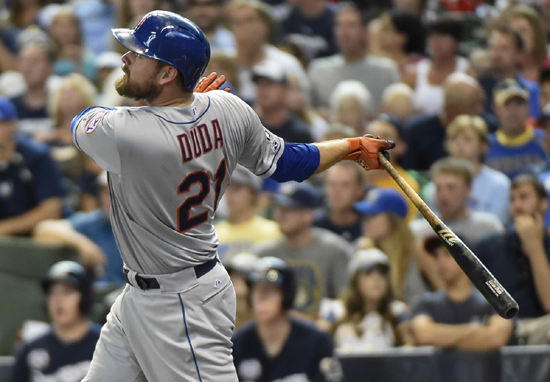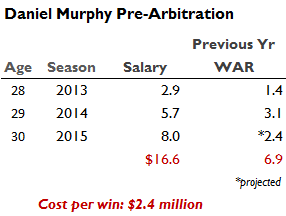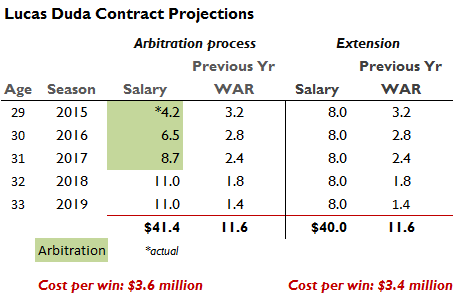
Last Spring, the Mets were debating whether to start Ike Davis, Lucas Duda, or even Josh Satin at first base. One year later, Ike Davis is wearing yellow and green in Oakland, and the team is considering a long-term contract for Duda, who is coming off a breakout season.
What is unique about Duda as an early extension candidate is his age. Most players with his service time (3.1 years), are younger than his 29 years. With two years of team control remaining, Duda would not be a free agent until his age-32 season. A fact that makes it tricky to evaluate his worth on a long-term deal, considering how players deteriorate with age.
 The decision to pay a player on a long-term deal before they hit free agency is based on the trade-off between arbitration-eligible seasons and free agent eligibility. Teams are willing to pay a little bit more now, during the arb-eligible seasons, when the player is likely most productive, in return for cost certainty later, by delaying when the player hits the free agent market.
The decision to pay a player on a long-term deal before they hit free agency is based on the trade-off between arbitration-eligible seasons and free agent eligibility. Teams are willing to pay a little bit more now, during the arb-eligible seasons, when the player is likely most productive, in return for cost certainty later, by delaying when the player hits the free agent market.
If the Mets signed Duda to a five-year deal today, they would essentially be “buying” two years of Duda’s free agent seasons. The logic goes that by paying for those future seasons now, they can potentially get them for a discount to what the market would demand later, and probably, with shorter term. The Mets rather have Duda signed at a current market rate for 2018 and 2019 service, than a future rate for those two years, plus an extra two or three years in term that it might take to get the deal done.
But do the Mets need to make that trade-off with Duda?
Let’s consider his possible arbitration value, extension worth, and future market value to get an idea.
First, his arbitration value. We already know his 2015 salary of $4.2 million. With two more years of arbitration eligibility, and continued success at the plate, that number is likely to climb. A good comparison may be Daniel Murphy‘s value.

Like Duda, Murphy had a breakout season in his late twenties, followed by another solid campaign in 2014. His pre-arbitration salary rose from $2.9 million in 2013 to $8 million this season.
It is reasonable to expect Duda’s arbitration values to rise in similar fashion, giving us a baseline to compare Duda at arbitration rates versus a possible extension amount.
As for an extension value, it is impossible to say exactly what it would be, but we can take a reasonable guess, looking at recent history. A player who offers a great comparable to Duda is Chris Johnson. The Braves extended him last May, when, like Duda, he was 29, had three plus years of service time, and was coming off a breakout season. He was also earning a similar $4.75 million the season he signed the extension. Johnson signed an extension for $23.5 million over three years. An $8 million per year price tag sounds about right for Duda.
Lastly, having found an arbitration and extension baseline, we now need a future market value for Duda if he was allowed to hit free agency in 2018. This past free agent season gives us two comparables. Both Michael Morse and Kendrys Morales are 1B/DH types, past the age of 30, who don’t offer much defensively, but can hit the ball for power. They both signed two-year deals this offseason for $16 and $17 million, respectively. If we put Duda is in a similar category to Morse and Morales as a free agent in 2018, but with a bit more upside, a two-year $22 million deal based on a 3.2 fWAR projection seems a fair estimate.
Okay, enough of the details, let’s see what all of this means!
If we assume that Duda’s performance will continue to be strong in 2015, and appropriately decline with age in each of the following seasons, we can set a baseline for expected performance in relation to expected salary.
As the table above demonstrates, using the baselines we discovered earlier, a five-year $40 million extension seems to be the right price to closely match what Duda would likely earn going through the arbitration process for the next two seasons and then trying to find a two-year deal in 2018. (Note: both options would be great values assuming the cost of a win to be $7 million in the open market, but the decision comes down to choosing the best of the two options).
Of course, all of this is based on the assumption that Duda will produce roughly 11.6 fWAR over the next five seasons, which, is probably not going to happen. Over the last five seasons, between 2010-2014, only 31 hitters in baseball have produced at least that much fWAR past their age-29 season. In other words, it’s not easy to do.
What the Mets gain in a contract extension for Duda is cost certainty past 2017. I don’t think they need it. Especially when, in exchange, they would be overpaying in the near term.
The arbitration process can be tedious, but what it does is set a market rate based on performance. Lucas Duda has one good season under his belt, but there is no guarantee that he will sustain that performance. By letting him go through the arbitration process each year, the Mets protect themselves from paying him across all years based on his performance this past season, which is likely to be his best, and perhaps, can save some money, if Duda were to regress.
If it is 2018 and beyond they are worried about, we have seen that players of Duda’s make-up and age don’t necessarily demand big contracts. It’s not unreasonable to think that by 2018, Duda is worth a lot less than today, and could be re-signed at a reasonable rate. Only if the Mets believe that his value would increase over the next three years should they be worried about locking in a rate today.
In the end, for me, $40 million over five years is the absolute highest the Mets should pay for Duda. It’s not unreasonable to believe they could get fair value for him at that price relative to his arbitration and re-sign later value. That being said, it comes with a lot of risk. What if Duda isn’t one of the top 30 hitters in baseball over the next five years? Which is why I say, let the arbitration process work it’s magic, and worry about 2018 when we get there.
Statistics courtesy of FanGraphs, Cot’s Baseball Contracts, and Baseball-Reference.Follow me on Twitter @OverWhitestone.















